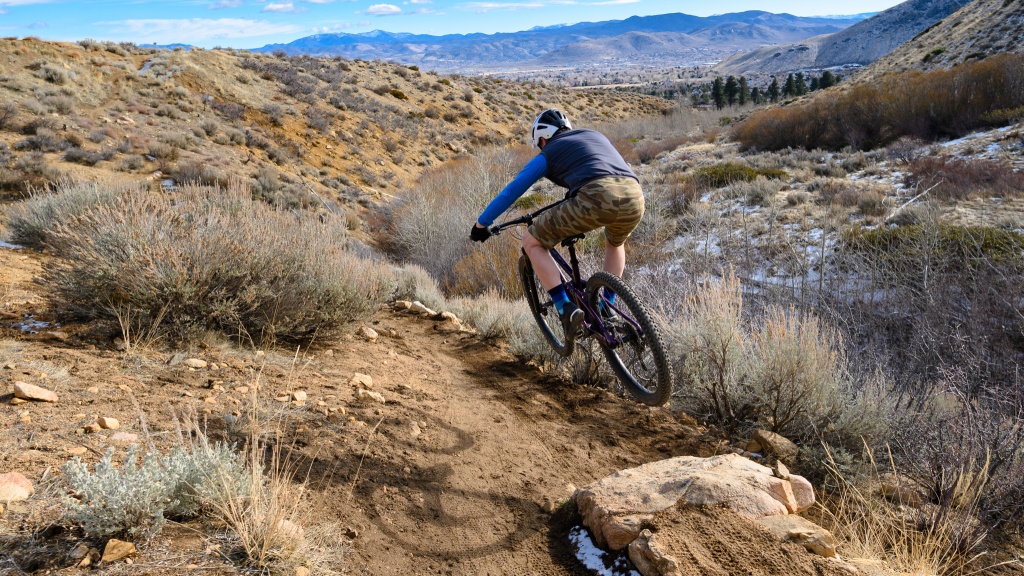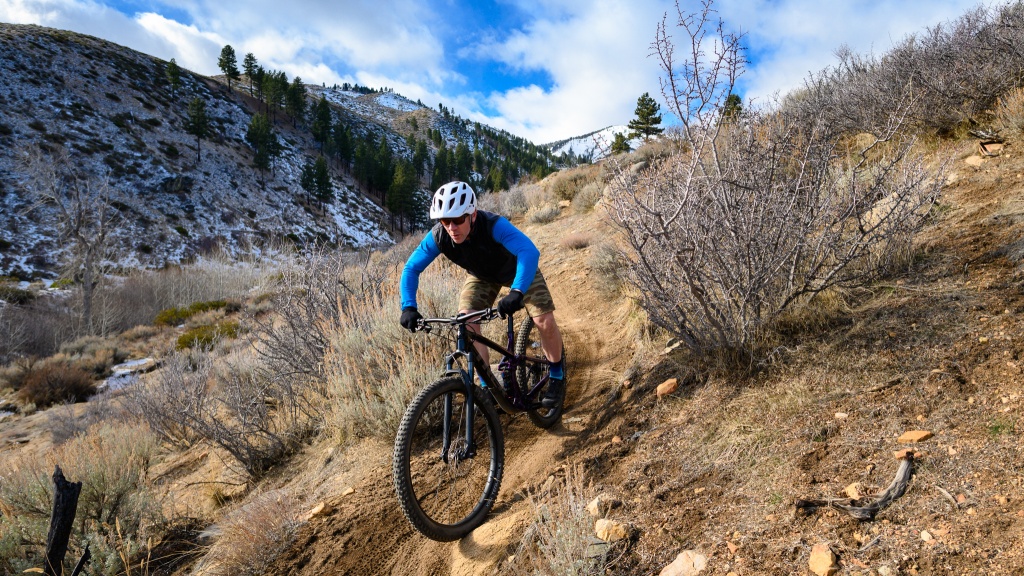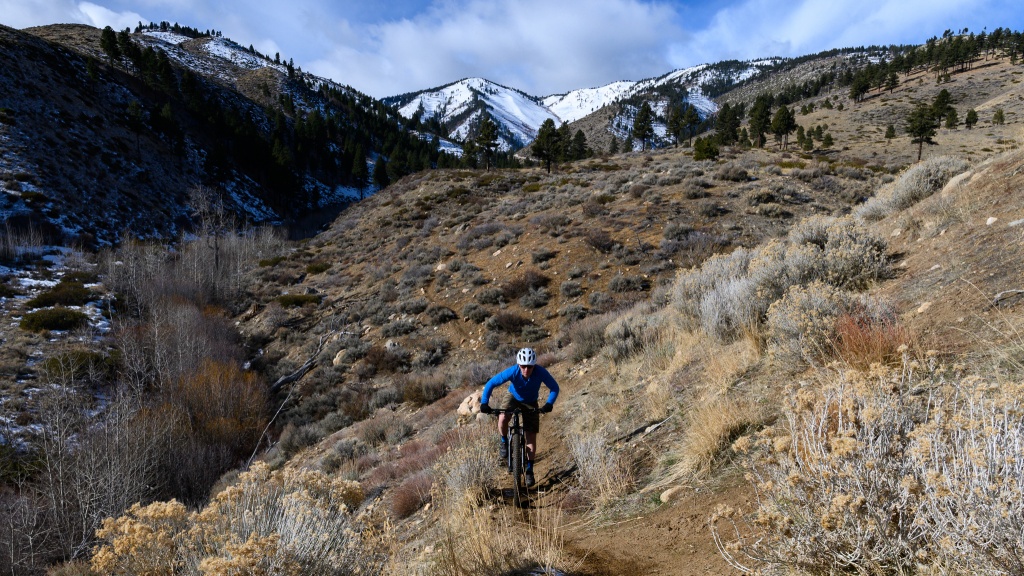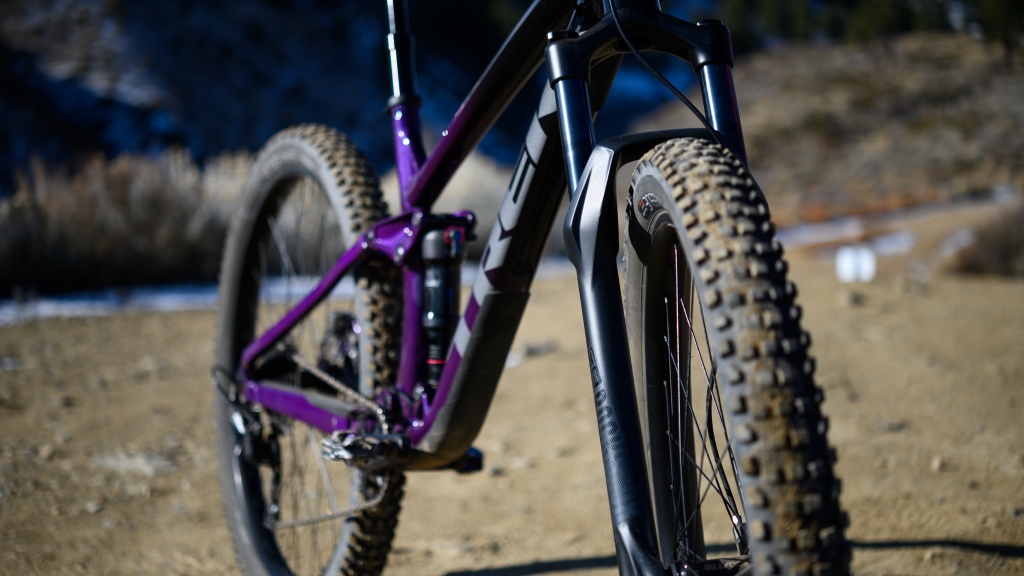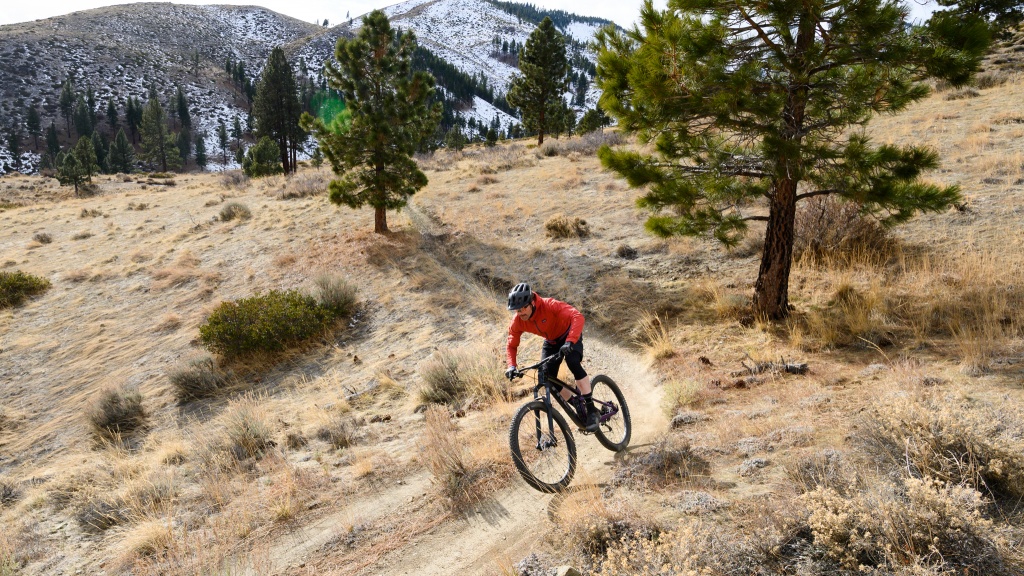Trek Fuel EX 5 Review
Our Verdict
Our Analysis and Test Results
Should I Buy This Bike?
Anyone just getting into the sport or operating on a tight budget would be wise to consider the Fuel EX 5. Trek's 2020 redesign of the Fuel EX line made this bike more capable and well-rounded than the previous version with an updated geometry and rear suspension design. The geometry is modern without being over the top, and this bike's supple suspension feels great whether you're cruising mellow flow trails or rolling down a steep rocky section. It's a little on the heavy side and it feels a bit lethargic on the climbs compared to some of the competition, but it's comfortable and reasonably efficient nonetheless. While it was bested by the competition in this review, our testers were actually quite impressed with the overall performance of the Fuel EX 5. This is a killer bike at this price.
Fun Factor
It used to be that testing bikes in this price range could be a little nerve-racking, but bikes like the Fuel EX 5 promote far more smiles and stoke than they did just a couple of years ago. This is thanks to modern trail bike geometry, and a thoughtful component spec that brings the performance of this entry-level model closer to that of the higher-end builds. Even our seasoned testers, all of whom are bike snobs with a preference for high-end models, had a blast while riding this relatively well-rounded and versatile mid-travel trail bike. It definitely has a preference for the descents, and it shines when pointed downhill with supple suspension, ample traction, and confidence-inspiring angles that don't hold you back.
The ABP suspension design of the Fuel EX is quite active, and it gives this bike a distinct trail-smoothing and ground-hugging feel, along with excellent stability on the descents. It's not the most lively or playful bike, but it flows down the trail comfortably with modern geometry that performs well on a huge range of terrain. The Fuel isn't an especially energetic climber, but it's competent, comfortable, and reliable enough on the ascents to get you back to the top for more laps or be a trusty companion on longer rides. Sure, there are a couple of components on this budget-minded build that we'd replace if this bike were our own, but this bike still punches above its weight class and is far more fun to ride than we'd expect at this price.
Downhill Performance
The Fuel EX 5 is a smooth operator on the descents. This bike is stable, ground-hugging, and has supple rear suspension that feels great when gravity takes over. The geometry inspires the confidence to let it rip on the descents and it has a user-friendliness that makes it easy to get along with, and versatility to be fun on a huge range of terrain. Its 130mm of rear-wheel travel is paired with a 140mm fork, landing it squarely in the mid-travel category which is ideal for most riders.
When Trek redesigned the Fuel EX models for the 2020 model year they addressed the majority of modern trail bike geometry trends, making it longer and slacker than its predecessor. This has made the Fuel more capable than ever before and this bike can tackle anything you're willing to try and ride down. They also gave it flip-chip adjustable geometry, so the rider can change the head and seat tube angles by 0.5-degrees and raise/lower the bottom bracket height by 5mm. This is a nice feature to dial in the geometry to your preferences, though our testers found the low setting to be pretty ideal for everyday trail riding. When we measured our test bike we found that it had exactly the numbers we like to see these days. A 66-degree head tube angle, 470mm reach, and a 1210mm wheelbase seem to be about the sweet spot for a modern mid-travel trail bike. Throwing a leg over it, however, all of our testers noted that this bike felt smaller than other size large test bikes with similar measurements. That said, this bike's long wheelbase helps to make it very stable at speed while the 66-degree head tube angle helps make it feel confident rolling into steeper terrain.
Trek's ABP suspension design makes for a very supple rear end, and this bike has excellent small bump compliance and performance over high-frequency chop. The Fuel hugs the ground and smoothes the trail very well, though it doesn't give much support in the mid-stroke. Unfortunately, the ground-hugging suppleness of the rear suspension takes a little life and pop out of the rear end making this bike a little less playful than it could be. That said, it likes to mob downhill and it does it well, just with a little less flair than some of the competition. The RockShox Recon fork is also nice and supple and pairs well with the rear suspension, though on some bigger hits and blunt edges it will occasionally remind you that it's a budget fork.
Trek has outfitted all of the new Fuel EX models with dropper posts and wide tubeless rims and tires. This includes the EX 5 model we tested that came with 2.6" wide Bontrager XR4 tires. These tires have loads of air volume that allow for running lower pressures, as well as a versatile tread pattern that helped give it predictable cornering traction. Our testers love the fact that bikes in this price come with dropper posts, and the TranzX model on the Fuel is far better than nothing, but the 130mm travel length felt a little short on a size large frame. The cockpit setup is generally fine, but our testers would have preferred a handlebar wider than 750mm for muscling this bike around. Like many of the other bikes in this review, the Fuel EX 5 comes with Shimano MT200 hydraulic disc brakes. These brakes work fine and they generally handle the stopping duties reasonably well, but they feel a little underpowered for the speeds this bike can travel.
Climbing Performance
The Fuel EX 5 is a relatively capable and comfortable going uphill, but climbing isn't this bike's strongest suit. It does just fine mind you, but it wouldn't be our first choice if we prioritized a quick or energetic feeling climbing experience. The geometry seems like it should be great, but it is held back a little by its weight, super active rear suspension, and some questionable components.
To be honest, the Fuel EX 5 climbs pretty darn well for a mid-travel bike in this price range, it's just bested on the climbs by some of the lighter weight and more efficient competition. It can manage just about any climb, it just has a somewhat lethargic feel to it due to its 33+ lb weight and super active rear suspension. The weight of this bike isn't terrible, but certainly noticeable when ridden back to back with lighter models. We're also fans of the Trek's ABP rear suspension design, although, without the RE:aktiv valving found on the rear shocks of their higher-end models, the EX 5 is a little more active in the back than we'd like. The pedal bob, when seated, isn't that bad, but it sucks the life out of any out-of-the-saddle efforts or short sprints uphill. Thankfully, the rear shock has a compression damping switch, which is very useful for climbing on any sort of road on this bike. In addition to the pedal bob, the Recon fork on this bike also had a tendency to dive when the rider's weight got forward. The Fuel EX 5 is best suited to less aggressive climbers who aren't racing anyone to the top of the hill.
On paper, the geometry of the Fuel EX 5 seems totally dialed and in line with all of the modern trends. In practice, this bike feels significantly smaller and more cramped than those numbers suggest. Our taller testers wished for a larger frame size, and this was confirmed when we tested a higher-end model in an XL. If you're between frame sizes, we'd suggest taking a test ride if you can and possibly sizing up. That said, testers found the seated pedaling position to be generally comfortable, though the shorter reach resulted in a relatively upright and unaggressive stance. The steep seat tube lines the rider up above the bottom bracket and power is transferred straight down into the cranks. The 1210mm wheelbase sounds somewhat long, but again, everything about this bike felt smaller than it measured, and it was generally easy to maneuver in virtually any terrain. There is a flip-chip to adjust the geometry of the Fuel EX slightly, though our testers found the Low setting to be good for everyday trail riding. This bike also has a knock block headset that prevents the fork from contacting and damaging the downtube. Testers found it to limit the turning radius in super tight corners.
The build of the Fuel EX 5 is a mixed bag on the climbs. The 2.6" wide Bontrager XR4 tires are a high point with a huge contact patch and a tread that provides loads of traction in a range of conditions. Testers were less than impressed with the spec of a Shimano Deore 10-speed drivetrain. Sure, the shifting is crisp and reliable, but it simply doesn't have the range offered by the competitors with 12-speed drivetrains. There's nothing worse than trying to downshift and realizing you're already in your easiest gear.
Build
The Fuel EX 5's frame is made from Trek's Alpha Platinum Aluminum with 130mm of rear-wheel travel using the Active Braking Pivot (ABP) suspension design. The 2020 Fuel models have seen some changes to this rear suspension design, mostly that they now use a fixed lower shock mount as opposed to the full-floater design of years past. The frame has a knock-block headset, flip-chip adjustable geometry, internal cable routing, integrated downtube and chainstay protection, and a bottle cage mount within the front triangle.
The 5 is the least expensive build in Trek's line of Fuel EX models, and the component specification reflects that. This is especially true of the suspension components, although they work reasonably well for the price. The 140mm of front wheel travel is handled by a RockShox Recon RL fork, the same fork found on several other bikes in this review. This fork works reasonably well and feels supple, though it can feel a bit flexy and harsh on bigger hits or high-speed chop. The RockShox Deluxe Select+ rear shock is a nice spec at this price point, and it feels especially supple paired with the ABP design on the rear end of this bike. It also has a compression damping/climbing switch, which was appreciated during long climbs.
Trek has spec'd the entire Fuel EX line with wide tubeless-ready rims and tires, which is a nice touch. The 5 comes with a Formula front hub and Bontrager rear hub laced to Alex MD35 tubeless-ready rims with a healthy 35mm internal width. These wide rims pair quite well with the 2.6" Bontrager XR4 tires mounted front and rear. The XR4 tires are solid all-around tires with loads of air volume and plenty of traction on most surfaces. They have also proved to be more durable than our testers expected.
As with most bikes in this price range, Trek has spec'd the Fuel EX 5 with a bunch of house-brand Bontrager cockpit components. This includes the 750mm wide handlebar and 50mm Bontrager Rhythm Comp stem. The 750mm wide handlebar is a little narrow by today's standards, but testers didn't find it to be a detriment to this bike's handling. The 130mm TranzX dropper seatpost is far better than none at all, but testers felt that it was a little short for a large frame. The Bontrager Arvada saddle was okay, but it was far from the most comfortable seat we've experienced lately.
Trek is offering the Fuel EX 5 at a very reasonable price, and one of the ways they've managed to keep the price so low is by spec-ing a Shimano Deore 10-speed drivetrain. In this day and age, we are accustomed to 11 and 12-speed drivetrains, so this seems a little weak. That said, Shimano's 10-speed works reliably even if it doesn't offer as much range for steep climbs as the competition. As with many of the other bikes in this test, the Fuel comes with Shimano MT200 hydraulic disc brakes. They work, but they have a cheap lever feel, aren't especially powerful, nor do they offer much modulation.
Value
Trek makes bikes for the masses, and with the Fuel EX 5, they are offering a quality, versatile trail bike at an accessible price. Of course, $2,100 is still a chunk of change, but in a world where mountain bikes can cost upwards of $10K, we feel this is a great value. This is an excellent entry-level trail bike that would serve a lot of riders in a lot of locations very well.
Conclusion
The Fuel EX 5 is a great entry-level mid-travel 29er at a reasonable price. Its all-around performance is solid, and it's a smooth descender and relatively solid climber. Unfortunately, it ends up getting a little lost in the middle of the pack compared to the best bikes in this review, but that shouldn't deter would-be buyers of this bike. This bike is versatile and well-rounded and an excellent option at this price.




